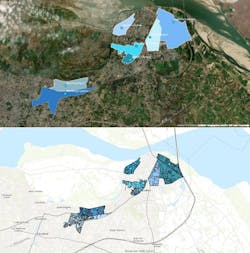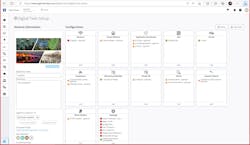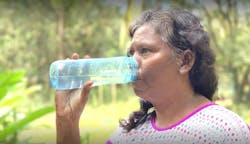Digital technology, powered by data, powers resilient water systems
Monstrous dams, human-made reservoirs, canals, sanitation plants, millions of miles of piping and water infrastructure have all driven the need for sustainable and resilient water management strategies. However, access to the world’s supply of water is at risk.
Huge swaths of the global population in developing regions still do not have access to clean drinking water. Farmers are struggling with finding consistent sources of irrigation. Communities are caught flat-footed, trying to deal with extreme weather and climate change that has brought on a cycle of drought and floods. At the same time, the infrastructure that supports these life-saving initiatives is aging, and there is too little budget, expertise and public support for the much-needed upgrades.
New digital technology provides the infrastructure intelligence that utilities, governments, non-governmental organizations (NGOs), and other stakeholders need to create sustainable and resilient water management strategies.
Data is key to understanding and conquering these challenges — using artificial intelligence (AI), machine learning (ML), Internet of Things (IoT) devices, and other advanced automation technologies to turn vast amounts of information into actionable insights. Armed with fingertip access to data, stakeholders can make informed decisions about water management in real time.
The challenges of data for water utilities
This new emphasis on data comes with challenges of its own. Executive pressure to “get more data” often results in a patchwork of sources that overwhelm decision makers, making it difficult for them to sift through the noise and come up with relevant, actionable information. Utilities that were once thirsty for data are now drowning in it, unable to see the forest through the trees as they struggle with information overload.
Increasing complexity across water infrastructure systems results in slower awareness of what is happening and how proposed actions will likely impact the situation. Then, once decisions are made, there is virtually no visibility into the results.
Unfortunately, water is too valuable a resource to rely on guesswork and hunches. The data is being collected but it is not being harnessed in a way that leads to better outcomes.
How new technologies transform water management
Fortunately, new technology is available to help utilities, governments and other stakeholders achieve better data management and analysis.
Open and interoperable across various systems, these applications break down data silos and consolidate critical information in a single repository where it can be organized, parsed and appropriately fed into analytics engines.
With technologies like these, data can flow in from a network of IoT sensors and edge devices to a digital twin. Then, artificial intelligence engines can provide actionable insights to augment human decision-making. Working together, these systems can make sure that the community’s water infrastructure assets are running reliably and optimally throughout their lifespan.
With the efficiencies of these technologies, engineers can dedicate more of their time to accelerate infrastructure intelligence. Infrastructure intelligence can help to reduce water losses from leaky pipes and bursts, as well as eliminate wastewater spills and contamination of natural waters.
The benefits of utilizing data with new technologies can be seen clearly in the following stories from India, the Philippines and California.
Delivering clean drinking water to developing regions
Access to fresh drinking water is a basic human need for health and well-being, but water stress and water scarcity remain a concern in many parts of the world — especially in developing regions.
India recently passed China as the most populous country on the planet and is emerging as one the world’s largest, most powerful economies. However, throughout much of the subcontinent, safe drinking water remains dependent on aging gravity-fed distribution networks.
The Atal Mission for Rejuvenation and Urban Transformation (AMRUT 2.0) is a federal government program in India that has made its mission to provide universal coverage of water supply through functional taps to all households in all the statutory towns in the country, as well as coverage of sewerage and septage management by 2026. This program includes new schemes, as well as the replacement of decaying pipes. AMRUT 2.0 promotes a secure, circular economy of water that will drive the recycling and reuse of treated sewage, rejuvenation of water bodies, and water conservation.
In the city of Ayodhya, the gravity-fed water network needed to be replaced with a pressurized water supply scheme. The existing network was losing half its water supply to leakage, making major upgrades necessary. The question, however, was where to make the upgrades and how extensive they needed to be. Mapping existing infrastructure was a major undertaking.
The Ayodhya Authority worked with Geoinfo, a geographic information system (GIS) consultancy company in Mumbai, to bring supervisory control and data acquisition (SCADA), GIS, hydraulic modeling, client information, and historical failure data into a connected data environment.
From there, Geoinfo was able to generate a hydraulic model and digital twin of the city’s water infrastructure. Engineers then used variable frequency drive pumps to test different nodal pressures, modeling how changes would impact the real-world environment.
Using digital twin technology powered by big data, the Ayodhya Authority was able to reduce design time by 75% while optimizing pipe diameters — saving USD $2.5 million in construction costs.
The ability to optimize the network by testing changes in software and monitoring a digital twin will save the city USD $1.5 million per year in operational costs and USD $46,000 in annual energy costs while eliminating 347 tons of carbon emissions per year.
Most importantly, the new pressurized network replaces the existing intermittent water supply with 24-hour access to clean water through functional taps to millions of residents, workers and visitors each year.
Ensuring water equity
In many parts of the world, people in remote regions spend hours each day walking to a clean water source to fetch drinking water. This time-consuming task prevents the local population (typically women and children) from other critical undertakings, such as working, going to school or developing the community.
The Sitio Sapang Munti is an indigenous community of 120 families that relies on the Ipo Watershed in the Philippines for its water needs. They travel miles each day to several tributaries that flow out from the Ipo Dam, a public work that provides drinking water and electricity to much of the metropolitan area around Manila. The water, however, has not been treated for contaminants by the time the Sitio Sapang Munti harvest it — presenting a threat to their health, their productivity and the surrounding environment.
The Manila Water Foundation (MWF) began working with the indigenous community to improve water access and equity by building a water system that will abstract and convey water from a nearby waterfall, divert it to a water treatment facility and safely supply water to a series of communal watering points strategically placed near settlements.
Using hydraulic modeling and analysis software, the team designed and laid out the distribution system in an optimal manner — keeping in mind the difficult terrain, remote geography and needs of the local people. Today, the water system provides more than 30 cubic meters of clean water per day to the Sitio Sapang Munti residents.
In addition, the MWF is working with the local community to train them to operate and manage the facility. The team is providing skills training and employment opportunities to an underserved population while ensuring a sense of ownership and pride in the new infrastructure project.
Turning wastewater into a reusable resource
The Sacramento and American Rivers in Northern California are notoriously over-used. They provide drinking water and sanitation to a burgeoning metropolis of 2.5 million people, as well as irrigation to the Central Valley — one of the most productive agricultural areas in the world. Finding enough water to supply both ends of the region’s economy can be difficult, especially when climate change is putting pressure on nearby reservoirs and other water infrastructure.
The EchoWater Project seeks to optimize the use of water by treating wastewater from Sacramento and turning it into reusable water for the Central Valley’s agriculture sector.
Originally projected to cost USD $2.1 billion, the project is the largest public works initiative in the city’s history, consisting of 22 separate construction projects around the region and making some experts predict that the high price tag would triple rates for residents. Program leaders knew that costs would have to come down to get critical buy-in from residents.
EchoWater decided to use data and digital applications to help manage costs, eventually building an extensive real-time digital twin of the entire project, spanning more than 100,000 construction events — many of which occurred simultaneously.
This workflow allowed project leaders to synchronize design and construction while optimizing workflows across thousands of stakeholders. The digital twin helped anticipate and mitigate potential obstacles and shutdowns while providing optimal and timely situational awareness of cost and schedule performance.
Working under this connected digital visual environment, EchoWater was completed USD $400 million under budget, eventually saving ratepayers more than half a billion dollars. More importantly, 135 million gallons of wastewater are treated every day and diverted across the Central Valley, where it is used to water one of the world’s most fertile agricultural regions.
Infrastructure intelligence is key
While some may take water for granted, access to clean drinking water is the foundation of human civilization. Sustainable and resilient water management strategies are needed to preserve this critical resource.
Infrastructure intelligence powered by data is key to understanding and solving today’s water challenges. Armed with actionable insights, water heroes around the world are making data-driven decisions that ensure that we can harness this valuable resource today and in the future.








